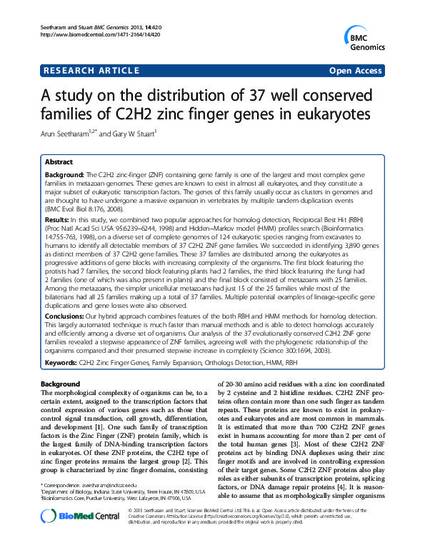
Article
A study on the distribution of 37 well conserved families of C2H2 zinc finger genes in eukaryotes
BMC Genomics
(2013)
Abstract
Background
The C2H2 zinc-finger (ZNF) containing gene family is one of the largest and most complex gene families in metazoan genomes. These genes are known to exist in almost all eukaryotes, and they constitute a major subset of eukaryotic transcription factors. The genes of this family usually occur as clusters in genomes and are thought to have undergone a massive expansion in vertebrates by multiple tandem duplication events (BMC Evol Biol 8:176, 2008).
Results
In this study, we combined two popular approaches for homolog detection, Reciprocal Best Hit (RBH) (Proc Natl Acad Sci USA 95:6239–6244, 1998) and Hidden–Markov model (HMM) profiles search (Bioinformatics 14:755-763, 1998), on a diverse set of complete genomes of 124 eukaryotic species ranging from excavates to humans to identify all detectable members of 37 C2H2 ZNF gene families. We succeeded in identifying 3,890 genes as distinct members of 37 C2H2 gene families. These 37 families are distributed among the eukaryotes as progressive additions of gene blocks with increasing complexity of the organisms. The first block featuring the protists had 7 families, the second block featuring plants had 2 families, the third block featuring the fungi had 2 families (one of which was also present in plants) and the final block consisted of metazoans with 25 families. Among the metazoans, the simpler unicellular metazoans had just 15 of the 25 families while most of the bilaterians had all 25 families making up a total of 37 families. Multiple potential examples of lineage-specific gene duplications and gene losses were also observed.
Conclusions
Our hybrid approach combines features of the both RBH and HMM methods for homolog detection. This largely automated technique is much faster than manual methods and is able to detect homologs accurately and efficiently among a diverse set of organisms. Our analysis of the 37 evolutionarily conserved C2H2 ZNF gene families revealed a stepwise appearance of ZNF families, agreeing well with the phylogenetic relationship of the organisms compared and their presumed stepwise increase in complexity (Science 300:1694, 2003).
Keywords
- C2H2 Zinc Finger Genes,
- Family Expansion,
- Orthologs Detection,
- HMM,
- RBH
Disciplines
Publication Date
2013
DOI
10.1186/1471-2164-14-420
Publisher Statement
Copyright Seetharam and Stuart 2013. Posted with permission.
Citation Information
Arun S. Seetharam and Gary W. Stuart. "A study on the distribution of 37 well conserved families of C2H2 zinc finger genes in eukaryotes" BMC Genomics Vol. 14 (2013) p. 420 Available at: http://works.bepress.com/arun-seetharam/4/
Creative Commons license

This work is licensed under a Creative Commons CC_BY International License.
